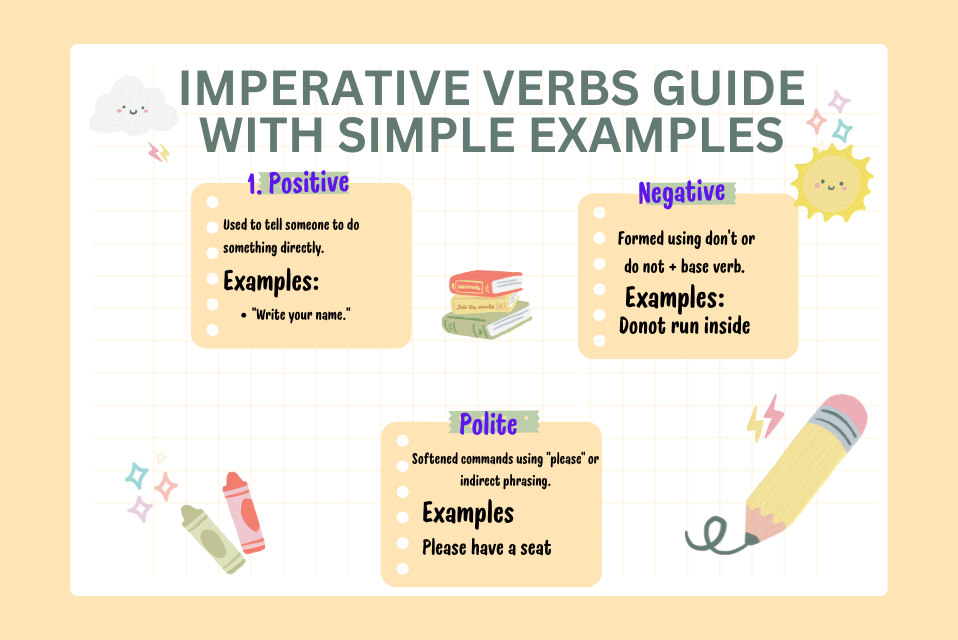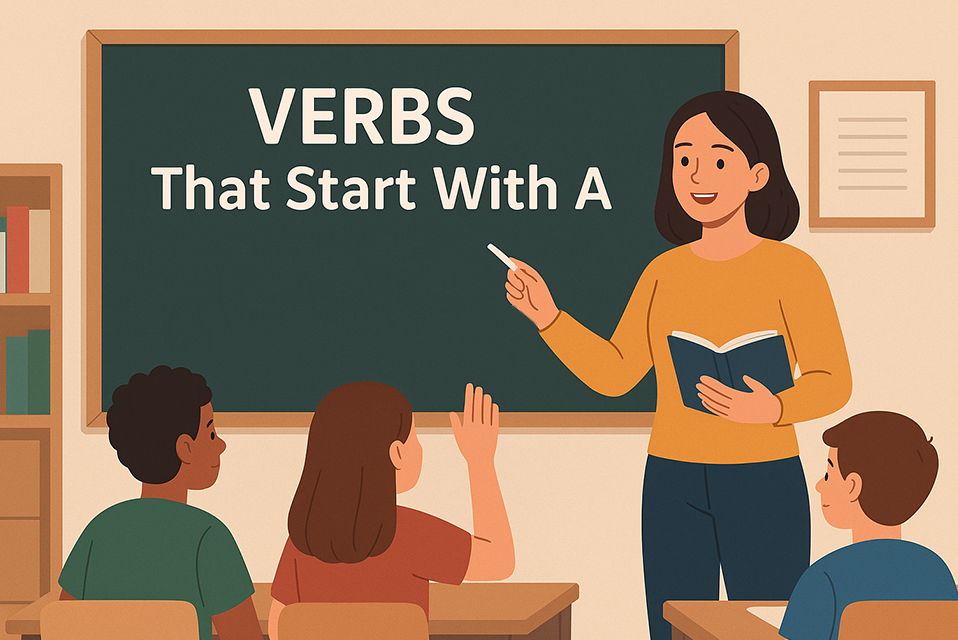Language is not just about expressing thoughts it is also about giving instructions, making requests, or issuing commands. In English grammar, this role is played by imperative verbs. These verbs are powerful because they work in the imperative mood, which is used to tell someone what to do.
Whether you hear someone say “Sit down,” “Close the door,” or “Please help me,” you are listening to imperative sentences. The verb comes first, and the subject “you” is implied, making it different from other sentence types.
What Are Imperative Verbs?
An imperative verb is an action word that creates a command, request, instruction, or direction. The sentence built with it is called an imperative sentence.
For example:
- “Open your book.” (command)
- “Please sit here.” (request)
- “Don’t touch that wire.” (warning)
- “Stay positive.” (advice)
Imperative Mood:
The imperative mood in English grammar is the form of a verb used to give orders, advice, instructions, or directions. Unlike the indicative mood (which states facts) or the subjunctive mood (which expresses wishes), the imperative mood directly addresses the listener. It is also different from causative verbs in English, which show that someone causes another person to do an action, while imperatives directly tell the listener what to do.
Structure of Imperative Sentences
Imperative verbs follow simple structures.
Positive Imperative:
- Verb (base form) + object (optional).
- Example: “Read the story.”
Negative Imperative:
- Do not / Don’t + base verb + object (optional).
- Example: “Don’t make noise.”
Polite Imperative:
- Please + base verb + object.
- Example: “Please pass the salt.”
Types of Imperative Sentences
1. Commands
These are direct and strong.
- “Stand up.”
- “Stop talking now.”
- “Close the window.”
2. Requests
These use polite words like please.
- “Please listen carefully.”
- “Help me with this work.”
- “Share your notes.”
3. Instructions
Used in rules, manuals, or guides.
- “Mix the flour with water.”
- “Click the submit button.”
- “Follow the rules carefully.”
4. Advice
Gentle reminders or suggestions.
- “Stay calm during exams.”
- “Eat healthy food.”
- “Be kind to others.”
5. Warnings / Prohibitions
Used to alert or prevent harm.
- “Don’t touch the hot pan.”
- “Beware of the dog.”
- “Do not enter.”
Grammar Rules for Imperatives
Base Verb Form: Always use the base form of the verb
- Wrong: “He goes home.”
- Correct: “Go home.”
No Subject: The subject is always you (understood).
- “(You) Open the book.”
Use of “Do not” / “Don’t” for negatives.
- “Don’t waste time.”
Politeness: Add please to soften the tone.
- “Please sit down.”
Emphasis with “Always” or “Never”:
- “Always do your best.”
- “Never lie.”
Command Verbs List (with Examples)
Here are some common action words used as command verbs in English:
- Sit
- Stand
- Write
- Read
- Open
- Close
- Stop
- Start
- Listen
- Speak
- Help
- Wait
- Follow
- Stay
- Move
- Don’t
Examples:
- “Write your name.”
- “Listen carefully to instructions.”
- “Don’t move.”
Imperative Verbs in Daily Life and Writing
Imperative verbs are everywhere. We use them in:
- Classrooms: “Open your books,” “Listen to me.”
- Workplaces: “Send the report,” “Follow the rules.”
- Cooking: “Chop the onions,” “Mix the spices.”
- Technology: “Click here,” “Download the file.”
- Safety Signs: “Do not enter,” “Keep out.”
Difference Between Imperative Verbs and Other Verb Forms
Indicative Mood vs Imperative Mood
- Indicative: “You are reading a book.”
- Imperative: “Read the book.”
Subjunctive vs Imperative
- Subjunctive: “I wish you were here.”
- Imperative: “Be here now.”
Declarative vs Imperative
- Declarative: “He likes tea.”
- Imperative: “Drink tea.”
Exercises on Imperative Verbs
Exercise 1: Identify Imperatives
Underline the imperative verbs.
- Open the window.
- Please sit down.
- Don’t run in the hall.
- Follow the rules carefully.
- Stay quiet during the test.
Answers:
- Open
- Sit
- Don’t run
- Follow
- Stay
Exercise 2: Fill in the Blanks
Use suitable imperative verbs.
- ______ your homework.
- Please ______ me with this bag.
- Don’t ______ too fast.
- ______ the TV.
- Always ______ your parents.
Answers:
- Do
- Help
- Drive
- Turn off
- Respect
Exercise 3: Rewrite in Imperative Form
- You should close the door.
- You are advised to stay safe.
- You must not waste water.
- Kindly help your friend.
- You are requested to read this passage.
Answers:
- Close the door.
- Stay safe.
- Don’t waste water.
- Help your friend.
- Read this passage.
Conclusion:
Imperative verbs are one of the most powerful tools in English grammar. They allow us to give commands, make requests, offer advice, issue warnings, and provide instructions. Understanding the imperative mood, learning the command verbs list, and practising with imperative sentence examples helps students and professionals use them effectively.
From classrooms to advertisements, from cooking recipes to safety instructions, imperative verbs guide human actions in countless ways. By mastering them, learners not only improve their grammar rules for imperatives but also their ability to communicate clearly and effectively. Along with imperatives, understanding spelling rules in English also helps learners write correctly, avoid mistakes, and build stronger communication skills.
FAQs on the Importance of imperative verbs
1. What are imperative verbs in English grammar?
Imperative verbs are action words used to give commands, requests, instructions, advice, or warnings. They are written in the imperative mood and usually start a sentence, with the subject “you” understood.
2. How do you identify an imperative sentence?
An imperative sentence usually begins with a verb in its base form. For example: “Sit down,” “Close the door,” “Don’t speak.” It does not mention the subject directly because it is always understood as you.
3. What is the difference between imperative and indicative verbs?
Indicative verbs state facts: “You eat breakfast at 8.”
Imperative verbs give orders: “Eat breakfast now.”







